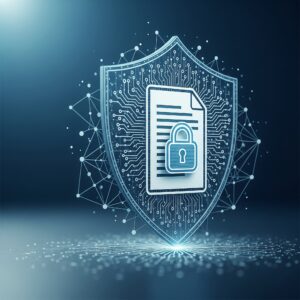In today’s digital landscape, data security is a critical concern for organizations across industries. With the rise in cyber threats, regulatory requirements, and consumer expectations, data encryption has become a fundamental component of compliance strategies. Many compliance frameworks and regulations mandate encryption to protect sensitive data, ensuring confidentiality, integrity, and availability.
This article explores the importance of data encryption in compliance, how it aligns with regulatory requirements, and best practices for implementation.
1. What is Data Encryption?
Data encryption is the process of converting readable data (plaintext) into an unreadable format (ciphertext) using cryptographic algorithms. Only authorized users with the correct decryption key can access the original data.
There are two main types of encryption:
- Symmetric Encryption – Uses the same key for encryption and decryption (e.g., AES-256).
- Asymmetric Encryption – Uses a public key for encryption and a private key for decryption (e.g., RSA, ECC).
Encryption ensures that even if data is intercepted, it remains unreadable to unauthorized parties.
2. Regulatory Requirements for Data Encryption
Many global compliance regulations require encryption to protect sensitive information. Below are some key regulations and their encryption mandates:
General Data Protection Regulation (GDPR) – Europe
- Article 32: Organizations must implement encryption as part of security measures to protect personal data.
- Article 34: If encrypted data is breached, notification requirements may be waived.
Health Insurance Portability and Accountability Act (HIPAA) – USA
- Mandates encryption for electronic Protected Health Information (ePHI) to prevent unauthorized access.
- Encryption is required for data at rest and in transit.
Payment Card Industry Data Security Standard (PCI DSS)
- Requires encryption of cardholder data during transmission across open networks (TLS 1.2+).
- Storage of sensitive cardholder data must be encrypted using strong cryptographic methods.
ISO 27001 (Information Security Standard)
- Requires organizations to implement encryption as a control to protect sensitive data.
California Consumer Privacy Act (CCPA)
- Companies must take reasonable security measures, including encryption, to protect consumer data.
Encryption plays a crucial role in ensuring compliance and avoiding hefty fines for non-compliance.
3. Why Encryption is Essential for Compliance Strategies
- Protects Sensitive Data
Encryption safeguards personally identifiable information (PII), financial data, and intellectual property, reducing the risk of breaches.
- Prevents Data Breaches and Legal Liabilities
Encrypted data is less valuable to cybercriminals. Even if hackers steal encrypted files, they cannot read the contents without decryption keys.
- Ensures Secure Data Transmission
- Encrypting data in transit (e.g., HTTPS, TLS, VPNs) prevents interception by attackers.
- Encrypting data at rest (e.g., databases, storage drives) ensures security even if physical devices are stolen.
- Helps Avoid Compliance Fines and Penalties
Non-compliance can lead to substantial fines. Encryption demonstrates proactive security measures and helps organizations mitigate financial and reputational risks.
- Enables Secure Cloud and Third-Party Compliance
With organizations increasingly relying on cloud services and vendors, encryption ensures data remains protected, even outside corporate networks.
4. Best Practices for Implementing Encryption in Compliance
To ensure effective encryption, organizations should follow these best practices:
- Encrypt Data at Rest and in Transit
- Use AES-256 for data at rest.
- Implement TLS 1.2 or higher for secure transmission.
- Implement Strong Key Management Policies
- Store encryption keys separately from encrypted data.
- Use a Hardware Security Module (HSM) or Key Management System (KMS) for secure key storage.
- Use End-to-End Encryption (E2EE)
- Encrypt data before transmission and ensure only the intended recipient can decrypt it.
- Regularly Update and Rotate Encryption Keys
- Rotate encryption keys periodically to prevent unauthorized access.
- Follow the least privilege principle for key access.
- Ensure Compliance with Industry Standards
- Follow NIST (National Institute of Standards and Technology) encryption guidelines.
- Regularly audit encryption configurations to meet compliance requirements.
- Train Employees on Encryption Practices
- Educate employees on the importance of encryption and secure data handling.
5. Conclusion
Data encryption is a non-negotiable element of modern compliance strategies. It plays a vital role in protecting sensitive data, preventing breaches, and ensuring regulatory compliance. Organizations that implement robust encryption practices can reduce security risks, avoid compliance penalties, and build trust with customers.
By integrating encryption into compliance frameworks, businesses can create a resilient security posture and stay ahead in an evolving regulatory landscape.







